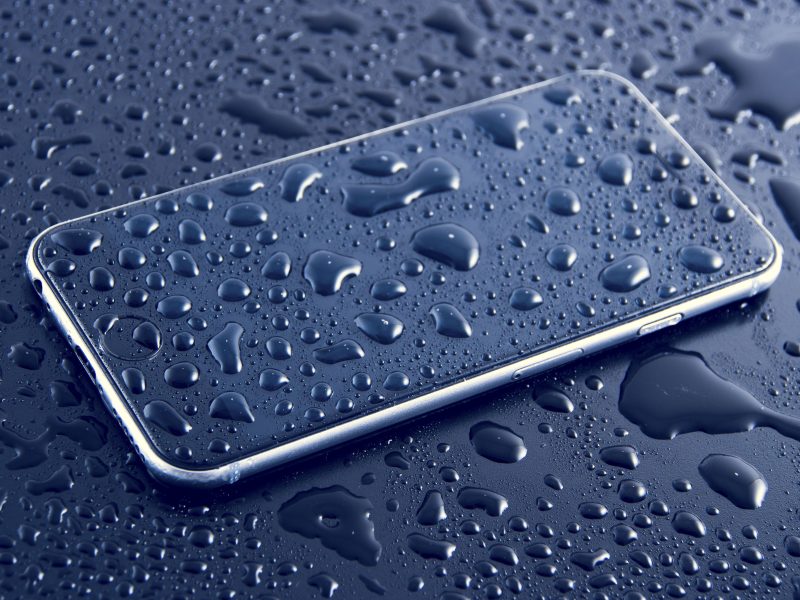If you’ve dropped your phone in water and are reading this in a hurry, skip down. We’ve got all the steps you need. Here's a summary:
- Dry it off with a paper towel. This should absorb the water on the surface, leaving only the water that has gotten inside the phone.
- Turn off the phone ASAP. You might be able to avoid any electrical short circuiting by powering down your device.
- Pull out the battery and SIM card. By taking apart your phone, you can check for water that may have seeped inside. If you see moisture, gently dry it as best you can, without damaging the components.
- Don’t touch it for a while. The air will naturally evaporate water that has gotten inside your phone, helping it dry out as time passes.
For the rest of the details you need, read on:
Don’t feel too smug just yet if you’re one of the lucky ones with a dry phone – to be blunt, it’s probably not a matter of if, but when you’ll deal with water damage to your phone. In fact, odds are you already have. (Relax, we didn’t say the word “toilet.” But we may have thought it.)
But with all the urban myths and misinformation floating around the interwebs, it’s difficult to know who to trust your phone safety to in times of emergency.
Fortunately, we’re experts at this kind of stuff. So have a look at our tips for what to do if you get water in your phone and how to prevent water damage in the first place.
1. Get your phone out of the water, pronto
It doesn’t need repeating, but yeah, time is of the essence here. A phone submerged for a few seconds has a much better chance of survival than one taking a dip for thirty seconds or more.
2. Also, fast – shut it off
The first concern here is not to short circuit. So if your phone isn’t off, shut it down as quickly as you can. If you’re an iPhone owner, now’s the time for that hard reset.
IMPORTANT: Don’t turn your phone back on anytime soon. If there’s water inside the phone, it can still short.
3. If you can, pull out the battery, SIM, and SD
The trick here is to get everything out in the open so it has access to more air flow. The iPhone only lets you remove the SIM, but for any other model, pull off the back panel and pop that battery out, as well. Take out the SD card, and anything else removable.
4. Dry it out
Dab your phone with a cloth or paper towel, tilt it side to side to allow water to drop out, and if you have one available, use a wet/dry vacuum to suck water out.
DON’T: Blow into the phone as that may only push water deeper in.
DON’T: Put your phone in the microwave. Seriously, do we have to tell you this?
DON’T: Use a blow drier or otherwise heat your phone up. Apple says the iPhone tops out at 113 degrees Fahrenheit. That’s not very hot.
Does putting your phone in rice really work? Short answer: No. There’s a whole lot of talk about dry rice wicking moisture away, but studies have shown that in a relatively dry climate, the best way to dry your phone is a good old-fashioned air dry. Combined with good air circulation, this method is actually quickest.
If you happen to live in Miami or Portland, Oregon, or somewhere else with super high humidity, you can try enclosing your phone with silicon pellets, which are more effective than rice. In truth, almost anything is more effective than rice, which has a relatively low saturation point. But whatever material you use, you still can't expect it to cure your phone.
5. Don’t touch it for a while
This one is controversial. Some people recommend leaving your phone off for a couple of days, at least. Their thinking goes that, while it may be difficult to be away from man’s best friend, if there’s moisture inside, the phone is liable to short circuit. But our master technician Matthew Zieminski says leaving it alone doesn't necessarily help it much, if at all. He told us, "Ultimately the only tried and true method to fix water damage is to take it completely apart, clean every component with Isopropyl Alcohol at 91% purity, perform microsoldering repair on corroded components, and replace the battery."
6. Try turning it on and see what happens
If all goes well, hopefully your phone will be working again in no time. If not, you can give us a call and we’ll see what we can do for you.

Preventative care
There are several preventative measures you can take to safeguard your phone against water damage as you lounge by the pool or beach this summer season.
One is to buy a water resistant phone in the first place. While most phones before this year have very little water resistance, newly-released models are offering much stronger defense against the liquid kryptonite. This article has some great recommendations.
Another thing you can do is buy a water resistant case, though if you’re using any of the phone’s ports, that renders the case pretty much useless.
If you know you’ll be by the water, you can always buy a dry bag for your phone – or do as this man does and life hack it with a Ziplock baggie and a straw.
What can Puls do for you
While we’re pretty optimistic we can help, with water damage it’s impossible to make a guarantee. So while our legal team insists that we make no promises, we offer a diagnostic of your device with all the same benefits as our other services.
If you wish to setup an appointment can do so easily online at Puls.com. With our flexible scheduling, you simply name the time and place and we’ll have a Saver dispatched to you on the double.





